Pricing Page Design: Boosting Conversions and Revenue
Hello there, digital design enthusiasts and aspiring conversion wizards! Let's get our creative juices flowing because today, we're diving deep into the fascinating world of pricing page design. In this world, psychology and aesthetics meet head-on to create powerful marketing strategies. We all know that the pricing page is a pivotal website component. It's the pot of gold at the end of the user's journey, right? So, ensuring it's compelling and designed to amplify conversions and bolster revenue is essential.
Did you know that well-optimised pricing pages can boost conversions by as much as 25%? You read that right! Research from the Nielsen Norman Group indicates that the power of the pricing page is not to be taken lightly. Yet, according to the same study, nearly 63% of businesses must take full advantage of their pricing page potential. If you're thinking, “Well, I don't want to be in that 63%”, you've come to the right place.
In this blog post, we will untangle the web of pricing page design, pinpointing exactly how it can serve as a secret weapon for increasing conversions and escalating your revenue. So, whether you're a seasoned web design professional, a budding entrepreneur, or anyone in between, stay tuned as we dissect the art and science of the pricing page. You're about to gain knowledge that could revolutionise your business's online performance. Buckle up and get ready for an exciting, enlightening ride!
Table of Contents
Understanding the Importance of Pricing Page Design
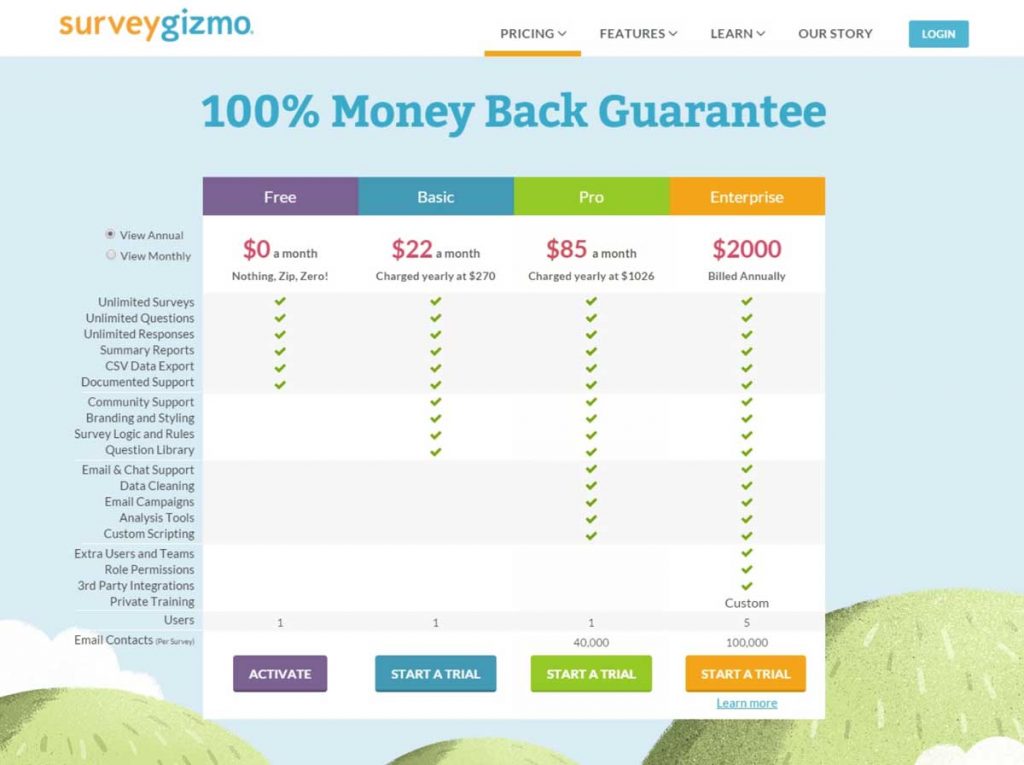
The pricing page is crucial when converting website visitors into paying customers. It serves as the final stop on the conversion funnel, where users evaluate the value of your offering and make a purchase decision. A well-designed pricing page can significantly impact user experience and conversion rates.
Think about it – if your pricing page is confusing, cluttered, or lacks transparency, users may lose trust in your brand and abandon their journey. On the other hand, a pricing page that presents information that appeals to different customer segments and instils confidence can drive higher conversions.
According to research, 67% of consumers consider clear pricing information the most critical factor when purchasing. This highlights the importance of presenting pricing details straightforwardly, avoiding complex jargon, and eliminating unnecessary information.
Critical Elements of an Effective Pricing Page
To design a pricing page that captures attention and compels users to take action, there are several key elements you need to consider:
Clear and Concise Pricing Information
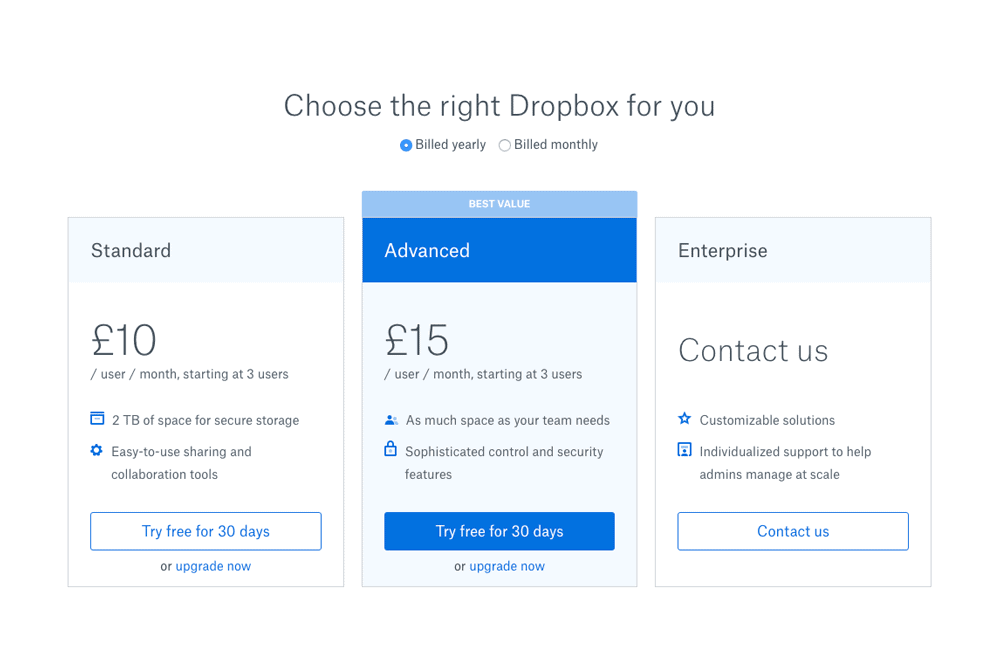
When potential customers arrive at your pricing page, it's crucial that they can easily comprehend your pricing options without any confusion. By presenting pricing details clearly and concisely, you eliminate any uncertainty and establish trust with your audience. One practical approach is avoiding technical jargon or industry-specific terms that could potentially alienate or confuse prospective customers.
To gain inspiration on creating an effective pricing page, let's focus on Dropbox's pricing page. Dropbox has masterfully crafted a pricing page showcasing its plans with transparency and precision. Doing so empowers users to compare different options and swiftly make well-informed decisions.
One key element that sets Dropbox's pricing page apart is its simplicity. The information is presented cleanly and organised, allowing visitors to absorb the details at a glance. The pricing plans are prominently displayed, with clear headings and concise descriptions that avoid unnecessary complexity.
Transparency is another crucial aspect of Dropbox's pricing page. Each plan is accompanied by a breakdown of its features and benefits, enabling users to understand the value they will receive for their investment. By highlighting the critical elements of each plan, Dropbox ensures that users can easily discern the differences and identify which plan aligns best with their specific needs.
Additionally, Dropbox prioritises ease of comparison on its pricing page. Users are provided with a side-by-side comparison of the plans, allowing them to comprehensively evaluate each plan's pricing, storage capacity, and features. This empowers visitors to make confident decisions based on their requirements, ensuring they select the best method.
Creating a pricing page that eliminates ambiguity is crucial to building trust with your audience. Dropbox achieves this by presenting all pricing details upfront without hidden fees or surprises. Users can see what they will be charged, fostering a sense of trust and reliability in the brand.
Tiered Pricing Structures
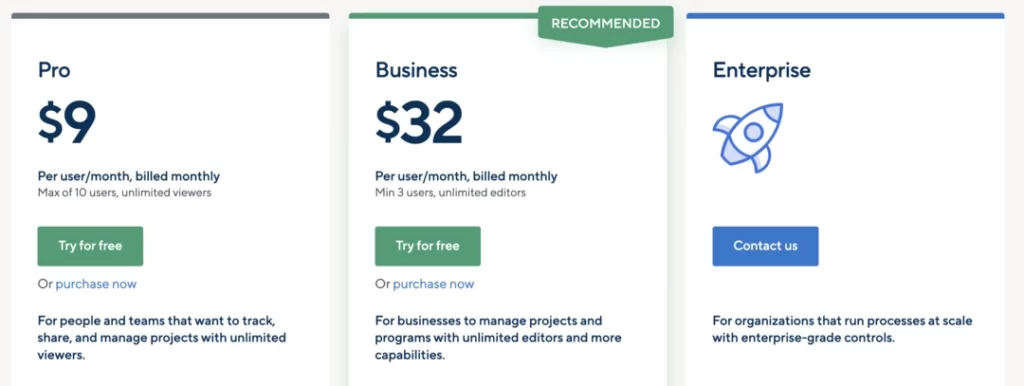
It has become increasingly evident in pricing strategies that a uniform approach does not suffice. The diverse customer needs and budgetary considerations landscape demands a more nuanced and flexible system. Acknowledging this reality, businesses have embraced the concept of tiered pricing structures, which enable them to cater to different customer segments and provide a range of options that align with their unique requirements.
One prime example of a sector successfully embracing tiered pricing is the software-as-a-service (SaaS) industry. SaaS companies recognise customers' varying usage levels, feature preferences, and budgetary constraints. By offering different plans tailored to these specific factors, they empower customers to choose the option that best suits their needs, fostering a mutually beneficial relationship.
The implementation of tiered pricing within the SaaS industry is multifaceted. Firstly, companies tailor their plans to accommodate different levels of usage. For instance, a basic plan may be suitable for light users or small businesses, while a more advanced plan caters to heavy users or larger enterprises. By allowing customers to select a program that matches their usage patterns, SaaS providers ensure that they pay only for the required resources, optimising cost-effectiveness.
Secondly, tiered pricing within the SaaS domain considers variations in feature preferences. Recognising that customers have different requirements in terms of functionality, SaaS companies offer tiered plans that unlock a range of features and capabilities. This allows customers to choose a plan that includes the specific functionalities they deem essential for their operations. Such customisation enables businesses to enhance their operational efficiency and leverage tools that align precisely with their needs.
Furthermore, the flexibility inherent in tiered pricing empowers customers to adapt to changing circumstances. Customers can seamlessly upgrade or downgrade their chosen plan as their requirements evolve. For example, a startup initially operating on a limited budget may opt for a more affordable plan with basic features. However, as the business expands and its needs grow, it can easily upgrade to a higher-tier plan that unlocks advanced features and provides the necessary scalability. Conversely, a company that experiences a temporary downturn can temporarily downgrade its strategy to optimise cost savings without sacrificing essential functionality. This adaptability ensures that customers can efficiently manage their budgets while enjoying the benefits of the software service.
Ultimately, implementing tiered pricing structures recognises and embraces the diversity of customer needs and budgets. It allows businesses to provide options that cater to different customer segments, ensuring a better fit between their offerings and the customers' specific requirements. By adopting this approach, companies foster customer satisfaction, establish long-term relationships, and optimise revenue generation by accommodating a wide range of customers.
Visual Hierarchy and Design

Creating an effective pricing page requires careful consideration of visual hierarchy, as it plays a crucial role in directing users' attention and emphasising essential pricing elements. By strategically employing typography, colour schemes, and graphic elements, you can not only enhance the visual appeal of the page but also enhance its user-friendliness.
Typography is pivotal in guiding users' attention and conveying the importance of different pricing elements. Different font sizes and styles can help distinguish essential information from secondary details. For instance, employing larger, bolder fonts for pricing plans or package names can immediately draw users' attention. On the other hand, using a more subtle font for additional features or descriptions can create a clear distinction between primary and secondary content.
Colour schemes are another powerful tool for establishing a visual hierarchy on a pricing page. By leveraging contrasting colours effectively, you can highlight important pricing information. For instance, using a vibrant colour for the pricing details, such as the cost or savings, against a more muted background can make it stand out. Employing colour psychology principles can also help evoke specific emotions or associations that align with your brand or pricing strategy.
Graphic elements, such as icons or illustrations, can be strategically placed to enhance the visual hierarchy on the pricing page. These visuals can serve as visual cues, drawing attention to crucial information or guiding users through the pricing options. For example, placing a prominent checkmark icon next to the most popular plan can make it more visually appealing and distinguish it from other options.
In addition to visual hierarchy, testimonials and social proof can be effectively highlighted to build trust and credibility. Positive customer reviews, or ratings can be visually emphasised through prominent quote boxes or badges. Placing these testimonials strategically on the page, ideally near the pricing options, can reinforce the value and reliability of your offerings, encouraging potential customers to purchase.
It is essential to ensure that your pricing page is responsive and optimised for desktop and mobile users. With the increasing use of mobile devices for online browsing, creating a seamless and visually engaging experience across different screen sizes is crucial. Responsive design techniques, such as adaptive layouts and flexible elements, can help maintain your pricing page's visual hierarchy and readability on various devices.
Strategic Call-to-Action (CTA) Placement
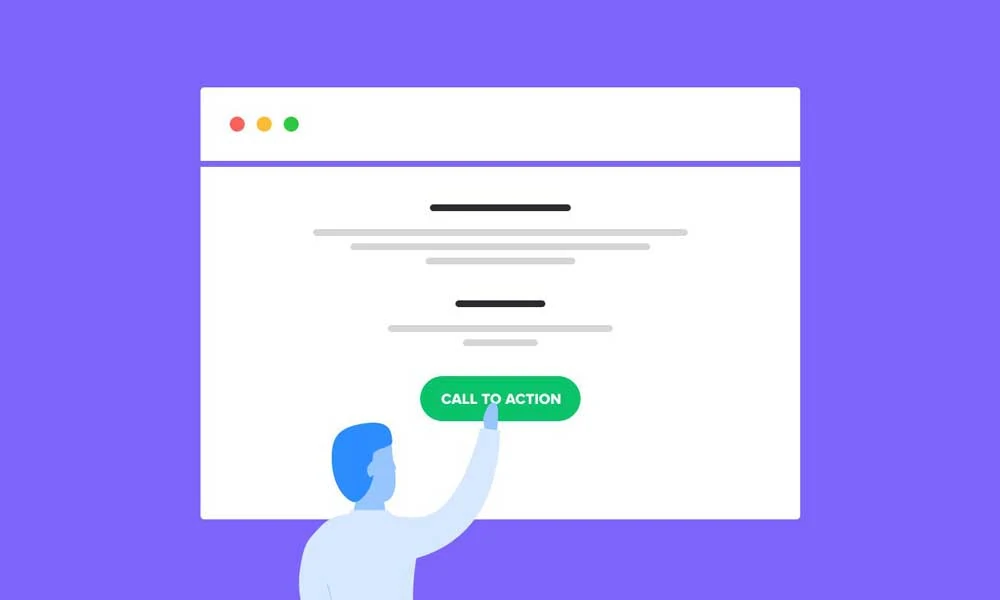
The design and placement of call-to-action (CTA) buttons on your pricing page are crucial in driving user engagement and conversions. By strategically positioning visually appealing CTAs, you can effectively guide your visitors towards the desired actions. It's essential to consider factors such as placement, colour, and wording, as they can substantially impact click-through and overall conversion rates.
To begin with, ensure that your CTAs are prominently displayed in easily visible areas of your pricing page. By placing them strategically, you can capture the attention of your visitors and increase the likelihood of them taking action. Consider aligning CTAs with your pricing options or packages, making it convenient for users to select their desired plan.
Furthermore, the visual appearance of your CTAs is equally essential. Choose colours that stand out and contrast nicely with the rest of the page. The purpose is to make your CTAs visually appealing, drawing attention to them while maintaining visual harmony with your overall design. Experiment with different colour combinations to find the ones that work best with your branding and resonate with your audience.
In addition to visual appeal, the wording of your CTAs is critical for driving conversions. Use action-oriented language that encourages immediate action and instils a sense of urgency or emphasises the value proposition of your offering. Instead of generic phrases like “Click here” or “Submit,” opt for more compelling statements that align with the desired user action. For example, you could use phrases such as “Start your free trial now” or “Unlock exclusive benefits today.”
To optimise your CTAs for maximum effectiveness, conduct A/B testing with different variations. Test various colours, wording, and placement to identify the most impactful CTAs for your audience. This iterative process allows you to gather data and insights, refining and improving your CTAs.
By strategically placing visually appealing CTAs, using persuasive language, and continually testing and optimising, you can enhance the performance of your pricing page. Ultimately, this will help you increase click-through rates, boost conversions, and drive revenue growth for your business.
Social Proof and Testimonials

In today's highly interconnected world, the opinions and experiences of others play a crucial role in shaping our decisions. People seek reassurance and credibility when purchasing, often relying on social proof to guide their decision-making process. Harnessing the power of social proof on your pricing page can significantly enhance trust and credibility among potential customers.
One effective way to incorporate social proof is by featuring customer testimonials, case studies, and reviews. These feedback forms provide valuable insights into the positive experiences and outcomes others have had with your product or service. Genuine testimonials from satisfied customers act as powerful endorsements, offering real-life success stories that resonate with prospective buyers. By sharing the stories of how your offerings have benefited existing customers, you can inspire trust and confidence in the minds of potential buyers.
To further enhance the impact of social proof, consider showcasing logos of well-known companies or industry influencers who have endorsed your offering. Displaying recognisable brands or influential personalities that vouch for your product or service can profoundly affect potential customers. Seeing familiar logos or names lends credibility and further reinforces the trustworthiness of your brand.
The strategic use of social proof helps to alleviate any doubts or hesitations that potential customers may have. By presenting them with concrete evidence of others' positive experiences, you can address common concerns and alleviate fears about the effectiveness or reliability of your offerings. This reassurance is a powerful incentive for potential buyers to move forward with their purchase, as they feel more confident about the value and benefits they will receive.
When leveraging social proof, it's important to curate and present testimonials, case studies, reviews, and endorsements in a compelling and visually appealing manner. Incorporate persuasive storytelling techniques to highlight your product or service's transformative impact on customers' lives. Use vivid language, before-and-after scenarios, and quantifiable results to emphasise your offer's value and effectiveness.
Additional Features and Add-ons
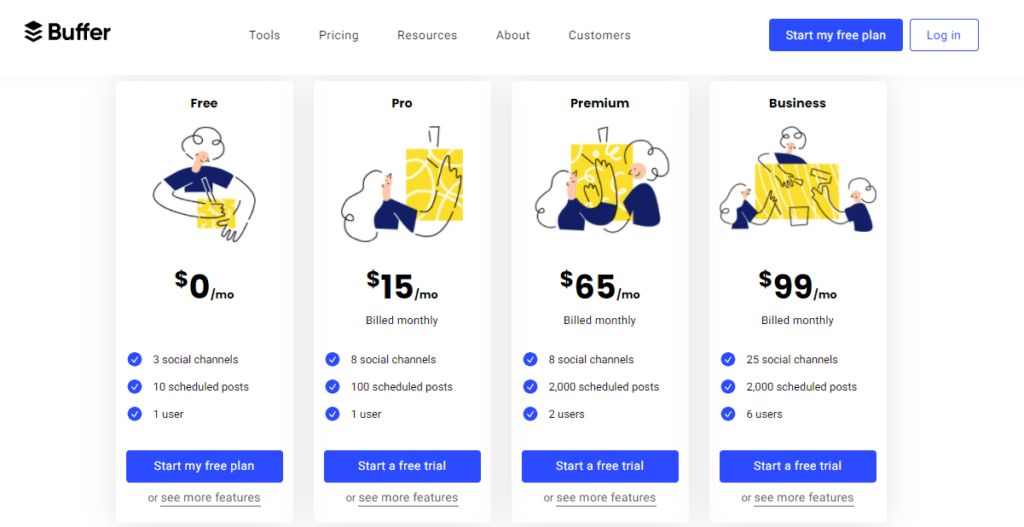
When showcasing your core pricing options, it is vital to seize the opportunity to go beyond the basics and provide additional features or add-ons to enhance the user experience and deliver exceptional value. By doing so, you can tap into upsell and cross-sell opportunities, ultimately boosting the average revenue per customer.
Imagine you are a website builder offering various pricing tiers to cater to different customer needs. While presenting these options, don't limit yourself to the basic package alone. Instead, please take a moment to highlight the enticing additional features or add-ons that customers can leverage to take their websites to the next level.
For instance, consider offering premium templates that showcase stunning designs and cutting-edge aesthetics. These templates can give customers a head start in creating visually appealing websites that captivate their visitors and set them apart from the competition. By emphasising the value and uniqueness of these premium templates, you can create a desire among customers to upgrade their plans and gain access to these exclusive design options.
In addition to premium templates, you can offer advanced customisation options as enticing add-ons. This might include tweaking the layout, colour schemes, or typography to align with customers' branding needs. By empowering users with greater control over the appearance and functionality of their websites, you provide them with a unique opportunity to showcase their brand identity and create a truly personalised online presence.
To maximise the impact of these add-ons, strategically position them as valuable enhancements that can significantly amplify the benefits customers receive. Emphasise how these additional features can help them attract more visitors, increase engagement, and achieve their business objectives more effectively. By articulating the value proposition of these add-ons, you can pique customers' interest and drive them towards upgrading their plans.
Moreover, when presenting the core pricing options alongside the add-ons, it's crucial to showcase the added value that customers will gain by selecting the higher tiers. Demonstrate how combining the core features and the extra enhancements creates a comprehensive solution that addresses their needs and provides an all-inclusive website-building experience. This holistic approach not only encourages customers to opt for higher-priced plans but also cultivates a sense of satisfaction and loyalty as they realise the full potential of your product.
By taking advantage of the opportunity to offer additional features or add-ons, you not only enhance the user experience but also boost your revenue potential. Upselling and cross-selling become natural byproducts of effectively showcasing the value and benefits of these extras. So, please make the most of this opportunity to go beyond the basics and create a compelling package that will entice customers to upgrade their plans and unlock the full potential of your product or service.
Psychological Strategies for Pricing Page Design
Understanding the psychological factors influencing purchasing decisions can help you optimise your pricing page for maximum impact. Here are some strategies to consider:
Anchoring and Decoy Pricing
Anchoring refers to the human tendency to rely heavily on the first piece of information encountered when making a decision. By strategically placing a high-priced option as an anchor, you can make other options appear more affordable and enticing.
Decoy pricing involves introducing a less desirable option to make another option seem more attractive by comparison. For example, offering a basic plan with limited features can steer customers toward a higher-priced plan that provides more value.
Framing and Presentation
The way you frame your pricing options can influence how customers perceive value. Instead of simply listing the features and prices, focus on presenting the benefits and outcomes customers can achieve with each plan. Frame your pricing to emphasise the value customers will receive for their investment.
For example, instead of saying “Basic Plan – $9.99/month,” rephrase it as “Unlock Essential Features and Save Time with our Basic Plan – Just $9.99/month.”
Limited-Time Offers and Scarcity
Scarcity creates a sense of urgency and can nudge users to make a purchase decision sooner rather than later. By incorporating limited-time offers or showcasing the scarcity of specific pricing options, you can tap into customers' fear of missing out (FOMO) and drive conversions.
Consider implementing countdown timers or indicating limited availability for specific plans or discounts. This can create a sense of urgency and push customers to take action.
Personalisation and Customisation
Personalisation can significantly impact how customers perceive the value of your pricing options. Tailoring your pricing page to address specific customer segments or offering customisation options can increase your offerings' perceived relevance and desirability.
For example, an email marketing service might offer different plans based on the size of the subscriber list or the number of monthly emails. By providing personalised recommendations or customisation options, you can cater to individual needs and increase the likelihood of conversion.
A/B Testing and Iterative Optimization

Designing an effective pricing page is a process that takes time and effort. It requires continuous improvement and optimisation through A/B testing and data-driven decision-making. Here are some steps to follow:
Importance of A/B Testing
A/B testing involves comparing two versions of your pricing page to determine which performs better in conversions. It allows you to make data-driven decisions and continuously improve your pricing page.
Research has shown that businesses conducting A/B testing experience an average conversion rate lift of 49%2. By constantly refining and optimising your pricing page, you can stay ahead of the competition and maximise revenue.
Key Elements to Test
During A/B testing, focus on testing different elements of your pricing page to identify the most effective strategies. These include pricing structures, design elements, CTAs, and social proof placement.
For instance, you can test different pricing tiers, varying placements of testimonials, or alternative wording for your CTAs. Through testing, you can uncover insights about your audience's preferences and optimise your pricing page accordingly.
Iterative Optimisation and Continuous Improvement
Optimising your pricing page is an ongoing process. Monitor analytics, gather user feedback, and analyse conversion data to identify areas for improvement. Use the insights gained from A/B testing to refine your pricing page iteratively.
Regularly revisit your pricing page and make incremental changes based on data-driven insights. This continuous improvement approach ensures that your pricing page remains effective and aligns with evolving customer preferences and market trends.
Conclusion
Designing a compelling pricing page requires a careful balance of aesthetics, psychology, and strategy. By understanding the importance of pricing page design, incorporating key elements, leveraging a psychological approach, and embracing iterative optimisation, you can create a pricing page that captivates your audience, boosts conversions, and maximises revenue.
Remember, the art of pricing page design is a continuous refinement process. Feel free to experiment and test different approaches. Implement the strategies discussed in this article and monitor the impact on your conversion rates. Dedication and data-driven decision-making can make your pricing page a powerful tool for business success.
Start implementing these strategies today, and watch your pricing page become a compelling conversion machine that propels your business forward!
